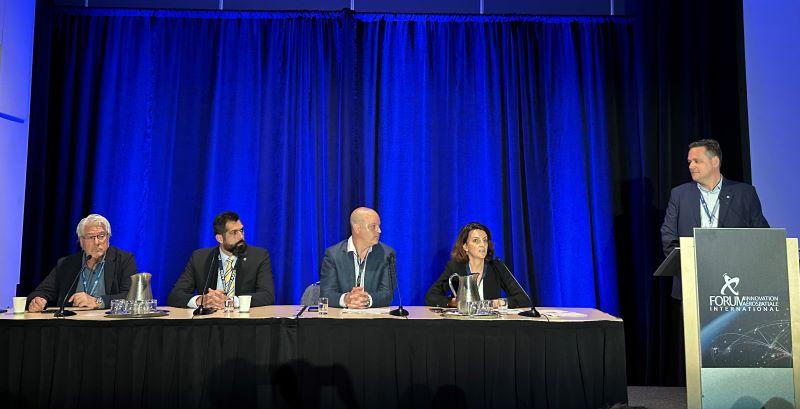This article is published in Aviation Daily, part of Aviation Week Intelligence Network (AWIN), and is complimentary through May 30, 2024. For information on becoming an AWIN Member to access more content like this, click here.

Panelists discuss challenges around adoption of sustainable aviation fuel at Aero Montreal’s International Aerospace Innovation Forum on May 21.
MONTREAL—A significant part of the International Aerospace Innovation forum being held May 21-22 in Montreal is dedicated to sustainable aviation and the technologies that can help industry reach—or at least come close to—its stated objective of being carbon neutral by 2050.
In addition to sustainable aviation fuel (SAF), there are four other alternative propulsion contenders to reduce aviation emissions: electric, hybrid electric, hydrogen combustion and hydrogen fuel cells. Yet electric or hydrogen-powered aircraft may not be adopted widely for many years given the nascent stage of some of their core technologies and the eventual need to invest big in new infrastructure.
“SAF is the here and now,” AeroDynamic Advisory MD Kevin Michaels said during a presentation, emphasizing SAF is the one alternative propulsion option “that can make a tangible impact on emissions reduction using what we have—it doesn’t require a change in infrastructure.” Michaels identified four challenges for SAF: regulation and motivation, resulting demand side issues given lack of price parity, investment constraints due to competing approaches, and supply volumes that are not adequate to replace current consumption levels of Jet A.
To address these challenges, Michaels said “a broad mandate may be needed,” citing the experience of the European Union (EU), Japan, Malaysia, Norway, Singapore and the UK. Among them, the EU is the most ambitious, requiring 70% of jet fuel must be sustainable by 2050. Malaysia is second with 47% by 2050, while Norway is targeting 30% of flights using sustainable fuel by 2030. Japan and Singapore have more modest targets. Japan has proposed 10% of its international flights use SAF by 2030, while Singapore is aiming for 3% to 5%, adjusting to market conditions.
While the cost of sustainable jet fuel is often seen as a barrier to widespread adoption, Michaels said the industry can bear some price increases and still grow healthily. AeroDynamic Advisory forecasts that if the cost of jet fuel doubles by 2042, either through SAF mandates or carbon taxes, air travel will still grow by 70%. “The rising cost of jet fuel is not an existential crisis for the industry,” he said.
At a panel discussion focused on SAF, participants highlighted several other challenges for eco-friendly jet fuel adoption. Michel Chornet, EVP of technology and global commercialization at Enerkem, said that “different sectors are competing for the same feedstocks,” with supply sometimes taken by “industries more advanced in their decarbonization efforts than aviation.”
The most mature production method for SAF uses waste oils, known as hydroprocessed esters and fatty acids (HEFA). Yet the road transport sector already uses much of the limited supply of these waste oils.
An alternative to waste oils is the so-called “third generation” of SAF, which includes feedstocks derived from biomass waste. In April, Honeywell said that its hydrocracking technology can be used to produce sustainable jet fuel from biomass. The company says that the new technology produces 3%-5% more SAF than other methods at a 20% lower cost.
“As demand for SAF continues to grow, the aviation industry is challenged by limited supplies of traditional SAF feedstocks such as vegetable oils, animal fats and waste oils,” Ken West, president and CEO of Honeywell Energy and Sustainability Solutions, said in a statement. With its new technology, Honeywell “will expand the feedstock options available in the industry to sources that are more plentiful, ultimately helping improve our customers’ ability to produce SAF,” he added.
Dale Smith, regional director of Enterprise Environmental Stability at Boeing, said during the panel that the aerospace giant’s “overall objective” when it comes to SAF is to “do our part to help accelerate commercial scale.” In April, Boeing announced it would purchase 9.4 million gal. of blended SAF (30% made from waste oils and 70% conventional jet fuel) to support its commercial operations in the U. S. This is the company’s largest SAF purchase to date.
Smith emphasized the importance of the aviation industry finding a way to adopt SAF on a larger scale within a reasonable time frame. “We just don’t have a lot of other options,” he said. “If we are going to decarbonize, we really have to solve this SAF code.”





